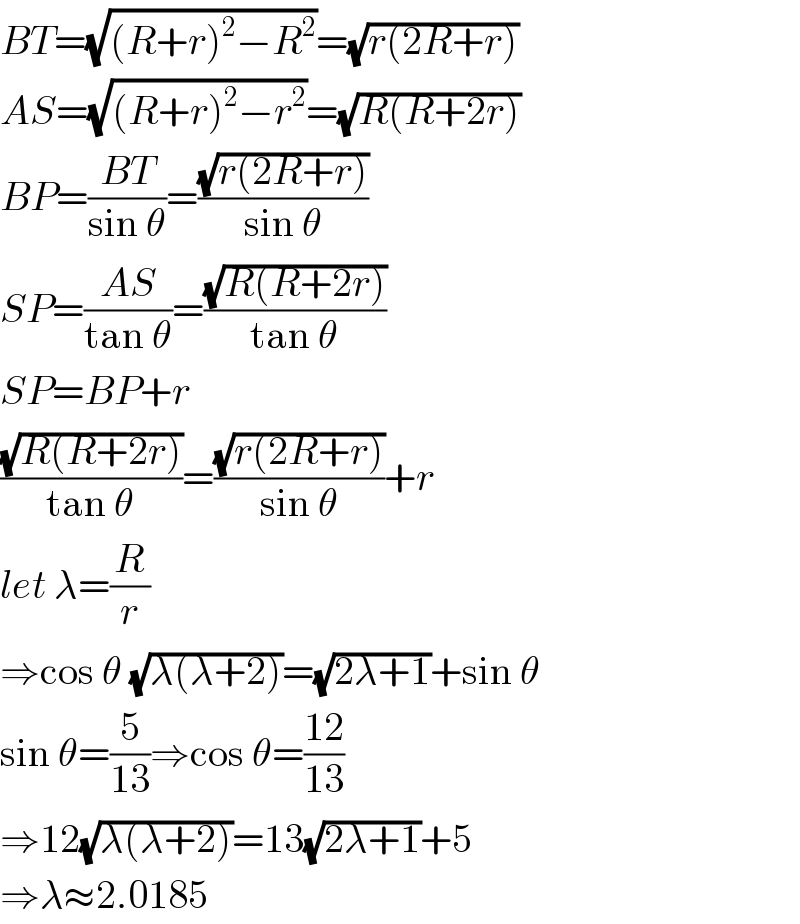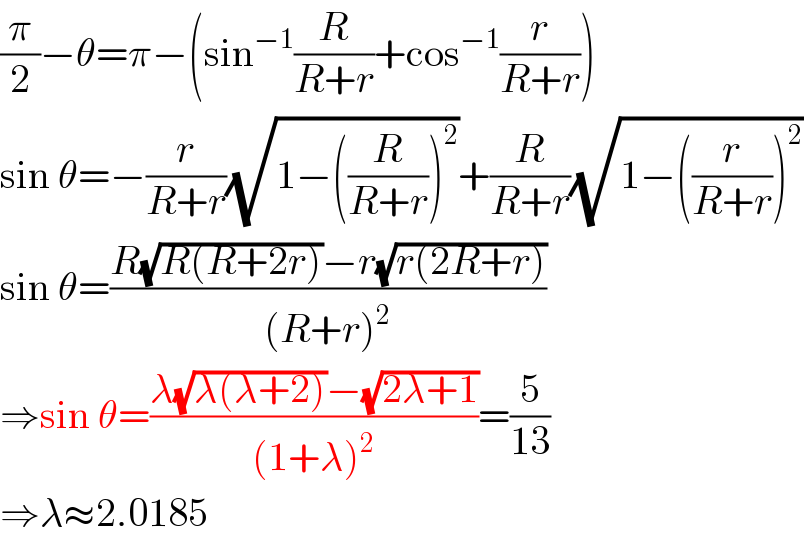
Question Number 52426 by ajfour last updated on 07/Jan/19

Commented by ajfour last updated on 07/Jan/19

$${Find}\:\frac{{R}}{{r}}\:\:{if}\:\:\mathrm{sin}\:\theta\:=\:\frac{\mathrm{5}}{\mathrm{13}}\:. \\ $$
Answered by mr W last updated on 07/Jan/19

$${BT}=\sqrt{\left({R}+{r}\right)^{\mathrm{2}} −{R}^{\mathrm{2}} }=\sqrt{{r}\left(\mathrm{2}{R}+{r}\right)} \\ $$$${AS}=\sqrt{\left({R}+{r}\right)^{\mathrm{2}} −{r}^{\mathrm{2}} }=\sqrt{{R}\left({R}+\mathrm{2}{r}\right)} \\ $$$${BP}=\frac{{BT}}{\mathrm{sin}\:\theta}=\frac{\sqrt{{r}\left(\mathrm{2}{R}+{r}\right)}}{\mathrm{sin}\:\theta} \\ $$$${SP}=\frac{{AS}}{\mathrm{tan}\:\theta}=\frac{\sqrt{{R}\left({R}+\mathrm{2}{r}\right)}}{\mathrm{tan}\:\theta} \\ $$$${SP}={BP}+{r} \\ $$$$\frac{\sqrt{{R}\left({R}+\mathrm{2}{r}\right)}}{\mathrm{tan}\:\theta}=\frac{\sqrt{{r}\left(\mathrm{2}{R}+{r}\right)}}{\mathrm{sin}\:\theta}+{r} \\ $$$${let}\:\lambda=\frac{{R}}{{r}} \\ $$$$\Rightarrow\mathrm{cos}\:\theta\:\sqrt{\lambda\left(\lambda+\mathrm{2}\right)}=\sqrt{\mathrm{2}\lambda+\mathrm{1}}+\mathrm{sin}\:\theta \\ $$$$\mathrm{sin}\:\theta=\frac{\mathrm{5}}{\mathrm{13}}\Rightarrow\mathrm{cos}\:\theta=\frac{\mathrm{12}}{\mathrm{13}} \\ $$$$\Rightarrow\mathrm{12}\sqrt{\lambda\left(\lambda+\mathrm{2}\right)}=\mathrm{13}\sqrt{\mathrm{2}\lambda+\mathrm{1}}+\mathrm{5} \\ $$$$\Rightarrow\lambda\approx\mathrm{2}.\mathrm{0185} \\ $$
Commented by MJS last updated on 07/Jan/19

$$\mathrm{this}\:\mathrm{can}\:\mathrm{be}\:\mathrm{solved}\:\mathrm{exactly}:\:\lambda=\frac{\mathrm{181}}{\mathrm{144}}+\frac{\mathrm{5}\sqrt{\mathrm{481}}}{\mathrm{144}} \\ $$
Commented by mr W last updated on 07/Jan/19

$${that}'{s}\:{great}\:{sir}!\:{thanks}! \\ $$
Commented by ajfour last updated on 08/Jan/19

$${Thank}\:{you}\:{mrW}\:{Sir},\:\mathcal{S}{traight}\:{and}\:\mathcal{N}{ice}! \\ $$$${MjS}\:{Sir}\:{is}\:{very}\:\mathcal{W}{ise}.\left({Thanks}\right). \\ $$
Answered by mr W last updated on 07/Jan/19

$$\frac{\pi}{\mathrm{2}}−\theta=\pi−\left(\mathrm{sin}^{−\mathrm{1}} \frac{{R}}{{R}+{r}}+\mathrm{cos}^{−\mathrm{1}} \frac{{r}}{{R}+{r}}\right) \\ $$$$\mathrm{sin}\:\theta=−\frac{{r}}{{R}+{r}}\sqrt{\mathrm{1}−\left(\frac{{R}}{{R}+{r}}\right)^{\mathrm{2}} }+\frac{{R}}{{R}+{r}}\sqrt{\mathrm{1}−\left(\frac{{r}}{{R}+{r}}\right)^{\mathrm{2}} } \\ $$$$\mathrm{sin}\:\theta=\frac{{R}\sqrt{{R}\left({R}+\mathrm{2}{r}\right)}−{r}\sqrt{{r}\left(\mathrm{2}{R}+{r}\right)}}{\left({R}+{r}\right)^{\mathrm{2}} } \\ $$$$\Rightarrow\mathrm{sin}\:\theta=\frac{\lambda\sqrt{\lambda\left(\lambda+\mathrm{2}\right)}−\sqrt{\mathrm{2}\lambda+\mathrm{1}}}{\left(\mathrm{1}+\lambda\right)^{\mathrm{2}} }=\frac{\mathrm{5}}{\mathrm{13}} \\ $$$$\Rightarrow\lambda\approx\mathrm{2}.\mathrm{0185} \\ $$
